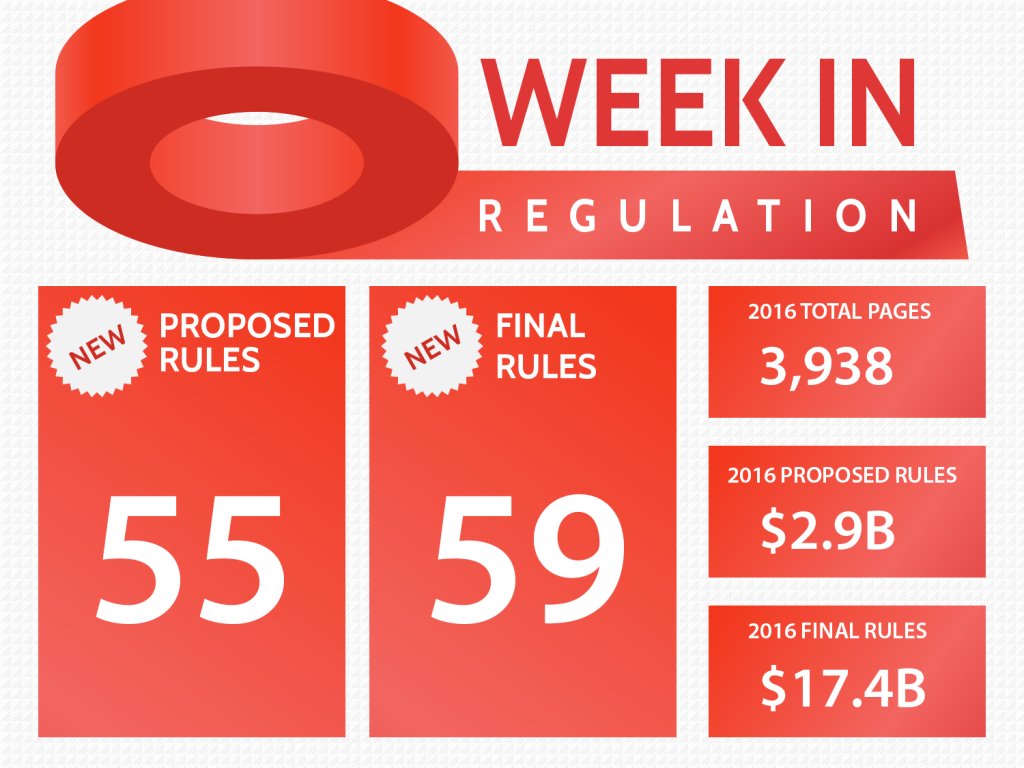Week in Regulation
January 25, 2016
A Cut in Regulatory Costs

After $18 billion in regulatory burdens last week, regulators slowed the pace, reducing regulatory costs. Annualized costs fell by $53 million, compared to $240 million in benefits; paperwork grew by 22,000 hours. A Department of Transportation (DOT) proposal for “Carrier Safety” led the week. The per capita regulatory burden for 2016 is already $63.
Regulatory Toplines
- New Proposed Rules: 55
- New Final Rules: 59
- 2016 Total Pages of Regulation: 3,938
- 2016 Final Rules: $17.4 Billion
- 2016 Proposed Rules: $2.9 Billion
The American Action Forum (AAF) has catalogued regulations according to their codification in the Code of Federal Regulations (CFR). The CFR is organized into 50 titles, with each title corresponding to an industry or part of government. This snapshot will help to determine which sectors of the economy receive the highest number of regulatory actions.

DOT’s “Carrier Safety Fitness Determination” modifies safety requirements for motor carriers by analyzing on-road safety data to determine whether certain vehicles are unfit for travel. Annual costs are just $10.6 million, compared to more than $240 million in estimated benefits. DOT estimates the rule could prevent 11 fatal crashes and more than 128 crashes that result in injuries.
The Securities and Exchange Commission (SEC) finalized a rule to simplify disclosure requirements. SEC is permitting emerging growth companies to omit certain financial information on official filings. The Commission estimates the rule could save companies more than $84 million in costs and 70,000 annual paperwork hours.
Affordable Care Act
Since passage, based on total lifetime costs of the regulations, the Affordable Care Act has imposed costs of $49.9 billion in state and private-sector burdens and 175.1 million annual paperwork hours.
Dodd-Frank
Click here to view the total estimated revised costs from Dodd-Frank; since passage, the legislation has produced more than 76.6 million paperwork burden hours and imposed $39.3 billion in direct compliance costs.
A Note on Paperwork
The Office of Management and Budget approved 35 paperwork requirements, decreasing the paperwork burden hours by 1,049,173 hours. There was one major change to existing paperwork requirements (defined as an hourly burden increase or decrease of 500,000 or greater).
The largest increase in paperwork burden hours imposed by an information collection requirement (ICR) was 100,000 hours from Grants.gov (EGOV). The largest decrease in paperwork burden hours imposed by an ICR was 1,100,000 hours from Grants.gov (EGOV).
Total Burdens
Since January 1, the federal government has published $20.4 billion in compliance costs ($17.4 billion in final rules) and has imposed 591,000 net paperwork burden hours (470,000 from final rules). Click below for the latest Reg Rodeo findings.











